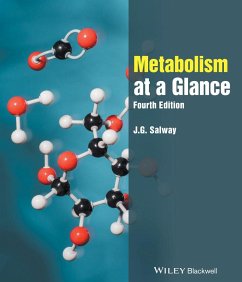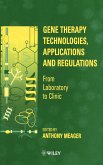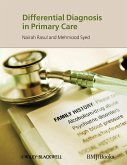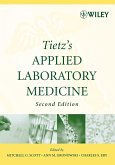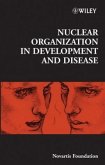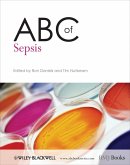J. G. Salway (University of Surrey)
Metabolism at a Glance
J. G. Salway (University of Surrey)
Metabolism at a Glance
- Broschiertes Buch
- Merkliste
- Auf die Merkliste
- Bewerten Bewerten
- Teilen
- Produkt teilen
- Produkterinnerung
- Produkterinnerung
Metabolism at a Glance presents a concise, illustrated summary of metabolism in health and disease. This essential text is progressively appropriate for introductory through to advanced medical and biochemistry courses. It also provides a succinct review of inborn errors of metabolism, and reference for postgraduate medical practitioners and biomedical scientists who need a resource to quickly refresh their knowledge. Fully updated and extensively illustrated, this new edition of Metabolism at a Glance is now in full colour throughout, and includes new coverage of sports biochemistry; the…mehr
Andere Kunden interessierten sich auch für
![Down Syndrome Down Syndrome]() William I. CohenDown Syndrome40,99 €
William I. CohenDown Syndrome40,99 €![Gene Therapy Technologies, Applications and Regulations Gene Therapy Technologies, Applications and Regulations]() Anthony Meager (Hrsg.)Gene Therapy Technologies, Applications and Regulations434,99 €
Anthony Meager (Hrsg.)Gene Therapy Technologies, Applications and Regulations434,99 €![Salivary Gland Cytology Salivary Gland Cytology]() Salivary Gland Cytology132,99 €
Salivary Gland Cytology132,99 €![Differential Diagnosis in Primary Care Differential Diagnosis in Primary Care]() Nairah RasulDifferential Diagnosis in Primary Care63,99 €
Nairah RasulDifferential Diagnosis in Primary Care63,99 €![Tietz's Applied Laboratory Medicine Tietz's Applied Laboratory Medicine]() Mitchell G. Scott / Ann M. Gronowski / Charles S. Eby / Norbert W. Tietz (eds.)Tietz's Applied Laboratory Medicine123,99 €
Mitchell G. Scott / Ann M. Gronowski / Charles S. Eby / Norbert W. Tietz (eds.)Tietz's Applied Laboratory Medicine123,99 €![Nuclear Organization in Development and Disease Nuclear Organization in Development and Disease]() Novartis Foundation SymposiumNuclear Organization in Development and Disease203,99 €
Novartis Foundation SymposiumNuclear Organization in Development and Disease203,99 €![ABC of Sepsis ABC of Sepsis]() ABC of Sepsis60,99 €
ABC of Sepsis60,99 €-
-
-
Metabolism at a Glance presents a concise, illustrated summary of metabolism in health and disease. This essential text is progressively appropriate for introductory through to advanced medical and biochemistry courses. It also provides a succinct review of inborn errors of metabolism, and reference for postgraduate medical practitioners and biomedical scientists who need a resource to quickly refresh their knowledge. Fully updated and extensively illustrated, this new edition of Metabolism at a Glance is now in full colour throughout, and includes new coverage of sports biochemistry; the metabolism of lipids, carbohydrates and cholesterol; glyceroneogenesis, alpha-oxidation and omega-oxidation of fatty acids. It also features the overlooked "Krebs Uric Acid Cycle". Metabolism at a Glance offers an accessible introduction to metabolism, and is ideal as a revision aid for students preparing for undergraduate and USMLE Step 1 exams.
Hinweis: Dieser Artikel kann nur an eine deutsche Lieferadresse ausgeliefert werden.
Hinweis: Dieser Artikel kann nur an eine deutsche Lieferadresse ausgeliefert werden.
Produktdetails
- Produktdetails
- Verlag: John Wiley & Sons / John Wiley and Sons Ltd
- 4 ed. Auflage
- Seitenzahl: 144
- Erscheinungstermin: 3. Februar 2017
- Englisch
- Abmessung: 332mm x 283mm x 12mm
- Gewicht: 761g
- ISBN-13: 9780470674710
- ISBN-10: 0470674717
- Artikelnr.: 45052253
- Herstellerkennzeichnung
- Libri GmbH
- Europaallee 1
- 36244 Bad Hersfeld
- gpsr@libri.de
- Verlag: John Wiley & Sons / John Wiley and Sons Ltd
- 4 ed. Auflage
- Seitenzahl: 144
- Erscheinungstermin: 3. Februar 2017
- Englisch
- Abmessung: 332mm x 283mm x 12mm
- Gewicht: 761g
- ISBN-13: 9780470674710
- ISBN-10: 0470674717
- Artikelnr.: 45052253
- Herstellerkennzeichnung
- Libri GmbH
- Europaallee 1
- 36244 Bad Hersfeld
- gpsr@libri.de
Jack Salway was Senior Lecturer within the Faculty of Health and Medical Sciences at the University of Surrey until 2008.
Preface ix Acknowledgements x Part 1 Energy metabolism 1 Introduction to metabolic pathways 2 2 Biosynthesis of ATP I: ATP, the molecule that powers metabolism 4 3 Biosynthesis of ATP II: mitochondrial respiratory chain 6 4 Oxidation of cytosolic NADH: the malate/aspartate shuttle and glycerol phosphate shuttle 8 5 Metabolism of glucose to provide energy 10 6 Metabolism of one molecule of glucose yields 31 (or should it be 38?) molecules of ATP 12 7 Anaerobic metabolism of glucose and glycogen to yield energy as ATP 14 8 2,3
Bisphosphoglycerate (2,3
BPG) and the red blood cell 16 9 Metabolism of triacylglycerol to provide energy as ATP 18 Part 2 Carbohydrate metabolism 10 Metabolism of glucose to glycogen 20 11 Glycogen metabolism I 22 12 Glycogen metabolism II 24 13 Glycogen metabolism III: regulation of glycogen breakdown (glycogenolysis) 26 14 Glycogen metabolism IV: regulation of glycogen synthesis (glycogenesis) 28 15 Pentose phosphate pathway: the production of NADPH and reduced glutathione 30 16 Regulation of glycolysis: overview exemplified by glycolysis in cardiac muscle 32 17 Glycolysis in skeletal muscle: biochemistry of sport and exercise 34 18 Regulation of gluconeogenesis 36 19 Regulation of Krebs cycle 38 20 Mammals cannot synthesize glucose from fatty acids 40 21 Supermouse: overexpression of cytosolic PEPCK in skeletal muscle causes super
athletic performance 42 22 Sorbitol, galactitol, glucuronate and xylitol 44 23 Fructose metabolism 46 24 Ethanol metabolism 48 Part 3 Fat metabolism 25 Pyruvate/malate cycle and the production of NADPH 50 26 Metabolism of glucose to fat (triacylglycerol) 52 27 Metabolism of glucose to fatty acids and triacylglycerol 54 28 Glycolysis and the pentose phosphate pathway collaborate in liver to make fat 56 29 Esterification of fatty acids to triacylglycerol in liver and white adipose tissue 58 30 Mobilization of fatty acids from adipose tissue I: regulation of lipolysis 60 31 Mobilization of fatty acids from adipose tissue II: triacylglycerol/fatty acid cycle 62 32 Glyceroneogenesis 64 33 Metabolism of protein to fat after feeding 66 34 Elongation and desaturation of fatty acids 68 35 Fatty acid oxidation and the carnitine shuttle 70 36 Ketone bodies 72 37 Ketone body utilization 74 38 ß-Oxidation of unsaturated fatty acids 76 39 Peroxisomal ß
oxidation 78 40
and ß
oxidation 80 41
-Oxidation 82 Part 4 Steroid metabolism 42 Cholesterol 84 43 Steroid hormones and bile salts 86 Part 5 Amino acid metabolism 44 Biosynthesis of the non
essential amino acids 88 45 Catabolism of amino acids I 90 46 Catabolism of Amino Acids II 92 47 Metabolism of amino acids to glucose in starvation and during the period immediately after refeeding 94 48 Disorders of amino acid metabolism 96 49 Phenylalanine and tyrosine metabolism 98 50 Tryptophan metabolism: the biosynthesis of NAD + , serotonin and melatonin 100 51 Ornithine cycle for the production of urea: the 'urea cycle' 102 Part 6 Metabolic channelling 52 Metabolic channelling I: enzymes are organized to enable channelling of metabolic intermediates 104 53 Metabolic channelling II: fatty acid synthase 106 Part 7 Purines, pyrimidines and porphyrins 54 Amino acid metabolism, folate metabolism and the '1
carbon pool' I: purine biosynthesis 108 55 Amino acid metabolism, folate metabolism and the '1
carbon pool' II: pyrimidine biosynthesis 110 56 Krebs uric acid cycle for the disposal of nitrogenous waste 112 57 Porphyrin metabolism, haem and the bile pigments 114 Part 8 Integration of metabolic pathways and diabetes 58 Metabolic pathways in fasting liver and their disorder in Reye's syndrome 116 59 Diabetes I: metabolic changes in diabetes 118 60 Diabetes II: types I and II diabetes, MODY and pancreatic ß
cell metabolism 120 61 Diabetes III: type 2 diabetes and dysfunctional liver metabolism 122 Index 125
Bisphosphoglycerate (2,3
BPG) and the red blood cell 16 9 Metabolism of triacylglycerol to provide energy as ATP 18 Part 2 Carbohydrate metabolism 10 Metabolism of glucose to glycogen 20 11 Glycogen metabolism I 22 12 Glycogen metabolism II 24 13 Glycogen metabolism III: regulation of glycogen breakdown (glycogenolysis) 26 14 Glycogen metabolism IV: regulation of glycogen synthesis (glycogenesis) 28 15 Pentose phosphate pathway: the production of NADPH and reduced glutathione 30 16 Regulation of glycolysis: overview exemplified by glycolysis in cardiac muscle 32 17 Glycolysis in skeletal muscle: biochemistry of sport and exercise 34 18 Regulation of gluconeogenesis 36 19 Regulation of Krebs cycle 38 20 Mammals cannot synthesize glucose from fatty acids 40 21 Supermouse: overexpression of cytosolic PEPCK in skeletal muscle causes super
athletic performance 42 22 Sorbitol, galactitol, glucuronate and xylitol 44 23 Fructose metabolism 46 24 Ethanol metabolism 48 Part 3 Fat metabolism 25 Pyruvate/malate cycle and the production of NADPH 50 26 Metabolism of glucose to fat (triacylglycerol) 52 27 Metabolism of glucose to fatty acids and triacylglycerol 54 28 Glycolysis and the pentose phosphate pathway collaborate in liver to make fat 56 29 Esterification of fatty acids to triacylglycerol in liver and white adipose tissue 58 30 Mobilization of fatty acids from adipose tissue I: regulation of lipolysis 60 31 Mobilization of fatty acids from adipose tissue II: triacylglycerol/fatty acid cycle 62 32 Glyceroneogenesis 64 33 Metabolism of protein to fat after feeding 66 34 Elongation and desaturation of fatty acids 68 35 Fatty acid oxidation and the carnitine shuttle 70 36 Ketone bodies 72 37 Ketone body utilization 74 38 ß-Oxidation of unsaturated fatty acids 76 39 Peroxisomal ß
oxidation 78 40
and ß
oxidation 80 41
-Oxidation 82 Part 4 Steroid metabolism 42 Cholesterol 84 43 Steroid hormones and bile salts 86 Part 5 Amino acid metabolism 44 Biosynthesis of the non
essential amino acids 88 45 Catabolism of amino acids I 90 46 Catabolism of Amino Acids II 92 47 Metabolism of amino acids to glucose in starvation and during the period immediately after refeeding 94 48 Disorders of amino acid metabolism 96 49 Phenylalanine and tyrosine metabolism 98 50 Tryptophan metabolism: the biosynthesis of NAD + , serotonin and melatonin 100 51 Ornithine cycle for the production of urea: the 'urea cycle' 102 Part 6 Metabolic channelling 52 Metabolic channelling I: enzymes are organized to enable channelling of metabolic intermediates 104 53 Metabolic channelling II: fatty acid synthase 106 Part 7 Purines, pyrimidines and porphyrins 54 Amino acid metabolism, folate metabolism and the '1
carbon pool' I: purine biosynthesis 108 55 Amino acid metabolism, folate metabolism and the '1
carbon pool' II: pyrimidine biosynthesis 110 56 Krebs uric acid cycle for the disposal of nitrogenous waste 112 57 Porphyrin metabolism, haem and the bile pigments 114 Part 8 Integration of metabolic pathways and diabetes 58 Metabolic pathways in fasting liver and their disorder in Reye's syndrome 116 59 Diabetes I: metabolic changes in diabetes 118 60 Diabetes II: types I and II diabetes, MODY and pancreatic ß
cell metabolism 120 61 Diabetes III: type 2 diabetes and dysfunctional liver metabolism 122 Index 125
Preface ix Acknowledgements x Part 1 Energy metabolism 1 Introduction to metabolic pathways 2 2 Biosynthesis of ATP I: ATP, the molecule that powers metabolism 4 3 Biosynthesis of ATP II: mitochondrial respiratory chain 6 4 Oxidation of cytosolic NADH: the malate/aspartate shuttle and glycerol phosphate shuttle 8 5 Metabolism of glucose to provide energy 10 6 Metabolism of one molecule of glucose yields 31 (or should it be 38?) molecules of ATP 12 7 Anaerobic metabolism of glucose and glycogen to yield energy as ATP 14 8 2,3
Bisphosphoglycerate (2,3
BPG) and the red blood cell 16 9 Metabolism of triacylglycerol to provide energy as ATP 18 Part 2 Carbohydrate metabolism 10 Metabolism of glucose to glycogen 20 11 Glycogen metabolism I 22 12 Glycogen metabolism II 24 13 Glycogen metabolism III: regulation of glycogen breakdown (glycogenolysis) 26 14 Glycogen metabolism IV: regulation of glycogen synthesis (glycogenesis) 28 15 Pentose phosphate pathway: the production of NADPH and reduced glutathione 30 16 Regulation of glycolysis: overview exemplified by glycolysis in cardiac muscle 32 17 Glycolysis in skeletal muscle: biochemistry of sport and exercise 34 18 Regulation of gluconeogenesis 36 19 Regulation of Krebs cycle 38 20 Mammals cannot synthesize glucose from fatty acids 40 21 Supermouse: overexpression of cytosolic PEPCK in skeletal muscle causes super
athletic performance 42 22 Sorbitol, galactitol, glucuronate and xylitol 44 23 Fructose metabolism 46 24 Ethanol metabolism 48 Part 3 Fat metabolism 25 Pyruvate/malate cycle and the production of NADPH 50 26 Metabolism of glucose to fat (triacylglycerol) 52 27 Metabolism of glucose to fatty acids and triacylglycerol 54 28 Glycolysis and the pentose phosphate pathway collaborate in liver to make fat 56 29 Esterification of fatty acids to triacylglycerol in liver and white adipose tissue 58 30 Mobilization of fatty acids from adipose tissue I: regulation of lipolysis 60 31 Mobilization of fatty acids from adipose tissue II: triacylglycerol/fatty acid cycle 62 32 Glyceroneogenesis 64 33 Metabolism of protein to fat after feeding 66 34 Elongation and desaturation of fatty acids 68 35 Fatty acid oxidation and the carnitine shuttle 70 36 Ketone bodies 72 37 Ketone body utilization 74 38 ß-Oxidation of unsaturated fatty acids 76 39 Peroxisomal ß
oxidation 78 40
and ß
oxidation 80 41
-Oxidation 82 Part 4 Steroid metabolism 42 Cholesterol 84 43 Steroid hormones and bile salts 86 Part 5 Amino acid metabolism 44 Biosynthesis of the non
essential amino acids 88 45 Catabolism of amino acids I 90 46 Catabolism of Amino Acids II 92 47 Metabolism of amino acids to glucose in starvation and during the period immediately after refeeding 94 48 Disorders of amino acid metabolism 96 49 Phenylalanine and tyrosine metabolism 98 50 Tryptophan metabolism: the biosynthesis of NAD + , serotonin and melatonin 100 51 Ornithine cycle for the production of urea: the 'urea cycle' 102 Part 6 Metabolic channelling 52 Metabolic channelling I: enzymes are organized to enable channelling of metabolic intermediates 104 53 Metabolic channelling II: fatty acid synthase 106 Part 7 Purines, pyrimidines and porphyrins 54 Amino acid metabolism, folate metabolism and the '1
carbon pool' I: purine biosynthesis 108 55 Amino acid metabolism, folate metabolism and the '1
carbon pool' II: pyrimidine biosynthesis 110 56 Krebs uric acid cycle for the disposal of nitrogenous waste 112 57 Porphyrin metabolism, haem and the bile pigments 114 Part 8 Integration of metabolic pathways and diabetes 58 Metabolic pathways in fasting liver and their disorder in Reye's syndrome 116 59 Diabetes I: metabolic changes in diabetes 118 60 Diabetes II: types I and II diabetes, MODY and pancreatic ß
cell metabolism 120 61 Diabetes III: type 2 diabetes and dysfunctional liver metabolism 122 Index 125
Bisphosphoglycerate (2,3
BPG) and the red blood cell 16 9 Metabolism of triacylglycerol to provide energy as ATP 18 Part 2 Carbohydrate metabolism 10 Metabolism of glucose to glycogen 20 11 Glycogen metabolism I 22 12 Glycogen metabolism II 24 13 Glycogen metabolism III: regulation of glycogen breakdown (glycogenolysis) 26 14 Glycogen metabolism IV: regulation of glycogen synthesis (glycogenesis) 28 15 Pentose phosphate pathway: the production of NADPH and reduced glutathione 30 16 Regulation of glycolysis: overview exemplified by glycolysis in cardiac muscle 32 17 Glycolysis in skeletal muscle: biochemistry of sport and exercise 34 18 Regulation of gluconeogenesis 36 19 Regulation of Krebs cycle 38 20 Mammals cannot synthesize glucose from fatty acids 40 21 Supermouse: overexpression of cytosolic PEPCK in skeletal muscle causes super
athletic performance 42 22 Sorbitol, galactitol, glucuronate and xylitol 44 23 Fructose metabolism 46 24 Ethanol metabolism 48 Part 3 Fat metabolism 25 Pyruvate/malate cycle and the production of NADPH 50 26 Metabolism of glucose to fat (triacylglycerol) 52 27 Metabolism of glucose to fatty acids and triacylglycerol 54 28 Glycolysis and the pentose phosphate pathway collaborate in liver to make fat 56 29 Esterification of fatty acids to triacylglycerol in liver and white adipose tissue 58 30 Mobilization of fatty acids from adipose tissue I: regulation of lipolysis 60 31 Mobilization of fatty acids from adipose tissue II: triacylglycerol/fatty acid cycle 62 32 Glyceroneogenesis 64 33 Metabolism of protein to fat after feeding 66 34 Elongation and desaturation of fatty acids 68 35 Fatty acid oxidation and the carnitine shuttle 70 36 Ketone bodies 72 37 Ketone body utilization 74 38 ß-Oxidation of unsaturated fatty acids 76 39 Peroxisomal ß
oxidation 78 40
and ß
oxidation 80 41
-Oxidation 82 Part 4 Steroid metabolism 42 Cholesterol 84 43 Steroid hormones and bile salts 86 Part 5 Amino acid metabolism 44 Biosynthesis of the non
essential amino acids 88 45 Catabolism of amino acids I 90 46 Catabolism of Amino Acids II 92 47 Metabolism of amino acids to glucose in starvation and during the period immediately after refeeding 94 48 Disorders of amino acid metabolism 96 49 Phenylalanine and tyrosine metabolism 98 50 Tryptophan metabolism: the biosynthesis of NAD + , serotonin and melatonin 100 51 Ornithine cycle for the production of urea: the 'urea cycle' 102 Part 6 Metabolic channelling 52 Metabolic channelling I: enzymes are organized to enable channelling of metabolic intermediates 104 53 Metabolic channelling II: fatty acid synthase 106 Part 7 Purines, pyrimidines and porphyrins 54 Amino acid metabolism, folate metabolism and the '1
carbon pool' I: purine biosynthesis 108 55 Amino acid metabolism, folate metabolism and the '1
carbon pool' II: pyrimidine biosynthesis 110 56 Krebs uric acid cycle for the disposal of nitrogenous waste 112 57 Porphyrin metabolism, haem and the bile pigments 114 Part 8 Integration of metabolic pathways and diabetes 58 Metabolic pathways in fasting liver and their disorder in Reye's syndrome 116 59 Diabetes I: metabolic changes in diabetes 118 60 Diabetes II: types I and II diabetes, MODY and pancreatic ß
cell metabolism 120 61 Diabetes III: type 2 diabetes and dysfunctional liver metabolism 122 Index 125

